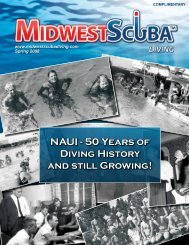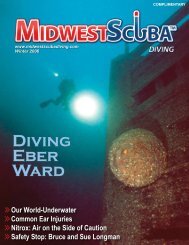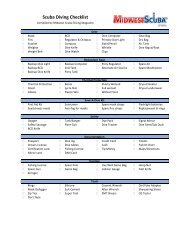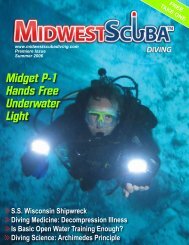great white shark adventure - Midwest Scuba Diving Magazine
great white shark adventure - Midwest Scuba Diving Magazine
great white shark adventure - Midwest Scuba Diving Magazine
Create successful ePaper yourself
Turn your PDF publications into a flip-book with our unique Google optimized e-Paper software.
Reverse<br />
Dive Profiles<br />
By Dan Orr, DAN<br />
President and<br />
Chief Executive Officer<br />
The ‘Well-Known Facts’<br />
DAN Discusses Repetitive<br />
<strong>Diving</strong> and the Twist On<br />
Reverse Dive Profiles<br />
On a recent dive trip, I overheard two divers talking about<br />
planning their second dive for the day. The first dive was a<br />
spectacular drift dive over a gently sloping wall in the warm,<br />
clear waters of the Caribbean. The divers had chosen to remain<br />
shallower than the rest of the group in order to photograph a pair<br />
of turtles doing their best to keep the local turtle population from<br />
becoming endangered.<br />
While moving to the next location, the divemaster announced that<br />
the second dive would take place at a similar location. Since their<br />
attention was focused elsewhere on the first dive, they wanted<br />
to see and enjoy the wall on the upcoming dive. This, however,<br />
created a dilemma. They had been taught, as most divers have,<br />
that the deepest dive always had to be made first. As one of the<br />
divers put it, “It is a well-known fact that you are likely to get<br />
bent if you don’t make the deepest dive first.”<br />
This well-known fact seems logical. A shallower second dive<br />
would appear to be a form of decompression following a<br />
relatively deep dive. This traditional wisdom was challenged in<br />
October 1999, when a workshop* funded by AAUS (American<br />
Academy of Underwater Sciences), DAN, DEMA (<strong>Diving</strong><br />
Equipment and Marketing Association), Dive Training magazine<br />
and the Smithsonian was held at the Smithsonian Institution to<br />
specifically address the issue of reverse dive profiles. Those<br />
present at the workshop represented the recreational, military,<br />
and research communities. The findings were as follows:<br />
• Historically, neither the U.S. Navy nor the commercial sector<br />
has prohibited reverse dive profiles.<br />
• Reverse dive profiles are being performed in recreational,<br />
scientific, commercial and military diving.<br />
• The prohibition of reverse dive profiles by recreational<br />
training organizations cannot be traced to any definite<br />
diving experience that indicates an increased risk of DCS<br />
(decompression sickness).<br />
• No convincing evidence was presented that reverse dive<br />
profiles within the no-decompression limits lead to a<br />
measurable increase in the risk of DCS.<br />
After reviewing and discussing all the evidence presented, these<br />
representatives of the diving industry came to the following<br />
conclusion:<br />
“We find no reason for the diving communities to prohibit reverse<br />
dive profiles for no-decompression dives less that 40 msw / 130<br />
fsw and depth differentials less than 12 msw / 40 fsw.”<br />
In the final analysis, however, it is up to you and your buddy to<br />
plan your dive in a manner that suits your objectives and gives<br />
you the <strong>great</strong>est level of confidence that the risk of injury will be<br />
minimal.<br />
Remember, dive tables or dive computers have no supernatural<br />
ability to protect you from injury due to DCS. I’ve heard Karl<br />
Huggins, co-inventor of the EDGE, the first electronic dive<br />
computer, say many times that there is no talisman, electronic or<br />
otherwise, that creates a magical shield that protects divers from<br />
DCS.<br />
Dive tables and computers are tools, not unlike your regulator or<br />
DIVING MEDICINE<br />
buoyancy compensation device. They are based on mathematical<br />
models, founded in theory, and designed to emulate body tissues,<br />
but those tools cannot take into account the wide range of body<br />
and tissue types, nor factors such as cold, fatigue and exertion,<br />
that may change the diver’s susceptibility during a dive. <strong>Diving</strong><br />
researchers do not completely understand the exact mechanisms<br />
of injury in regards to DCS. Even when divers use tables or<br />
computers correctly, there is always a risk of DCS.<br />
Divers can take the following steps to reduce the risk of DCS:<br />
• Dive conservatively. Don’t push the limits. Many experts<br />
believe that the closer one comes to the U.S. Navy nodecompression<br />
limits, the <strong>great</strong>er the risk of DCS.<br />
• Avoid minimum surface intervals. Surface intervals allow<br />
offgassing of residual nitrogen. Increasing your surface<br />
interval will reduce your nitrogen load and offer <strong>great</strong>er<br />
benefit to the slower tissue compartments.<br />
• Make slow ascents and make safety stops. Research has<br />
shown that slow ascents and safety stops help to reduce<br />
the size and quantity of gas bubbles in circulation. Many<br />
researchers believe there is a relationship between gas bubbles<br />
in circulation and the likelihood of DCS symptoms.<br />
• Manage additional risks. If the risks change during the dive,<br />
it may be wise for the diver to reduce bottom time or increase<br />
the safety stop or both.<br />
• Avoid cold and dehydration. By being properly hydrated<br />
and using appropriate exposure protection, you can help<br />
decrease DCS risks. Dehydration and cold may actually<br />
increase risk of DCS by affecting the body’s blood flow,<br />
which influences nitrogen exchange through respiration.<br />
• Maintain a high level of personal fitness. Exercise tolerance<br />
is essential to safe diving. Exhaustion may significantly<br />
increase risk.<br />
When it comes to your well-being and the safety of your diving<br />
partner, don’t take anything for granted. Well-known facts, once<br />
thought to be absolute, are regularly being challenged.<br />
Some of these “well-known facts” have been with us for quite<br />
some time, but I wouldn’t stake my life on them.<br />
* Vann RD, Denoble PJ, Pollock NW. Reverse Dives And<br />
Project Dive Exploration. Reverse Dive Profiles Workshop;<br />
1999 Oct 29-30 2000; 1999: 181-187.<br />
Snapshot: Dan Orr<br />
Dan Orr has been diving for 40-plus years and has held<br />
membership and leadership positions in many notable<br />
diving organizations such as NAUI, PADI, ACUC, YMCA,<br />
NASE, IAND, UHMS, NACD, AUAS, the Institute of <strong>Diving</strong><br />
and the Explorers Club. He is the recipient of numerous<br />
awards such as AUAS’s NOGI Award for Sports/<br />
Education, NAUI’s Leonard Greenstone Award for <strong>Diving</strong><br />
Safety, the Our World-Underwater Award and Beneath<br />
the Sea’s Diver of the Year. He was named Chairman of<br />
the Board of the Historical <strong>Diving</strong> Society for 2004 and<br />
currently serves on the DEMA board of directors.










